At a distance of 9 km from Nashik Central Bus Station, Muktidham is a marble temple complex located at Deolali Gaon on the suburbs of Nashik. It is one of the popular tourist attractions in the city of Nashik.
Muktidham Temple complex was built by Late Sri JayramBhai Bytco in 1971. An abode of most of the gods and goddesses of the Hindu religion, this splendid shrine displays the replica of all the 12 Jyotirlingas of India. It is believed that a holy darshan of this shrine provides as much virtue as a visit to four holy places, which makes this magnificent shrine a crowded pilgrim center.
It is a magnificent piece of architecture, made with white marble from Makran in Rajasthan. There is a temple dedicated to Lord Krishna in the Muktidham complex. The walls of Krishna temple have paintings depicting scenes from life of Krishna and Mahabharata. These were painted by a noted painter Raghubir Mulgaonkar. Unique to this temple are eighteen chapters of Bhagavad-Gita written on the walls.
Apart from the replicas of all the twelve Jyotirlingas and temple of Sri Krishna there are also idols of all major Hindu Gods and Goddesses like Vishnu, Goddess Lakshmi, Rama, Lakshman, Sita, Hanuman, Durga, Ganesh. Further, the complex also houses a dharamshala, which can accommodate at least 200 pilgrims. Thousands of Hindu devotees visit Muktidham Temple during Kumbh Mela.
At a distance of 2 km from Nashik Central Bus Station, Ramkund is the most important sacred bathing tank in the Panchavati area of Nashik City. This is one of the popular places to visit in Nashik during Kumbh Mela.
Ram Kund, measuring 27 x 12 sq. m was built by Chitrarao Khatarkar in 1696 AD. According to the legend, this sacred bathing tank on the bank of river Godavari is believed to be the spot where Lord Rama had taken his bath during their exile. It is also said that Lord Rama has performed his father’s funeral rites in this Kund and hence Ram Kund is also known as Asthi Vilaya Tirtha (Bone Immersion Tank). This is one of the must-visit places as part
of Nashik tour packages.
Ram Kund is a holy place for Hindus. Devotees believe that a dip in this tank will fulfill their wishes and also free them from their sins. There is a popular belief that salvation to the soul of the dead person is easily achieved by immersing their ashes in the holy waters of this tank. Ashes of prominent personalities like Mahatma Gandhi, Jawaharlal Nehru, Indira Gandhi, Rajiv Gandhi, and Dr. Rajendra Prasad were immersed in Ram Kund. Adjacent to the Ramkund, there is a Gandhi Talav (lake) having a white marbled monument, built-in memory of Mahatma Gandhi.
At a distance of 2.5 km from Nashik Central Bus Station, Sri Kalaram Temple is an old Hindu shrine situated in the Panchavati area of Nashik city in Maharashtra. It is probably the most important temple in Nasik, and among the must include places in Nashik tour packages.
Kalaram Temple is dedicated to Lord Rama, who has been enshrined inside the sanctum sanctorum in the form of a black stone idol. It is one of the important places to visit in Nashik. The temple was built by Sardar Rangarao Odhekar in 1790 AD. It was said that Odhekar had a dream that the statue of Rama in black color was in the Godavari River. Odhekar took the statue from the river and built the temple. The temple formed a pivotal role in the Dalit Movement in India. Dr. Ambedkar led a protest outside the temple on 2nd March 1930, to allowing Dalits into the temple.
The architectural design of this temple is similar to the temple of Trimbakeshwar. The temple has been constructed completely out of black stones and four entrance doors, one each facing East, West, South, and North. The temple is surrounded by an enclosure that comprises 96 pillars. The stones used in the construction of the temple were brought from Ramshej. It took almost 12 years to complete, with the help of over 2000 workers. Kalaram Temple is around 70 feet high and has a gold-plated peak. The summit of the Kalaram Mandir is made up of 32 tons of gold.
The idol of Lord Rama as well as of Lakshmana and Sita are carved out of black stone, hence the temple got its name, Kalaram, meaning black Ram. At the entrance, there is an idol of Lord Hanuman, which is also carved out of a black stone. There is an impression of the footprint on a stone near an old tree which is thought to be the footprints of Lord Dattatreya. The temple is surrounded by several smaller temples such as the Vithal Temple, Ganapathi Temple, and Maruti Temple. Pilgrims also visit the Kapaleshwar Mahadev temple and Sita Gufaa near the Kalaram Temple. The festivals of Ramnavami, Dussehra, and Chaitra Padwa (Hindu new year day) are celebrated with much fanfare at the temple.
Timings: 6 AM – 12 PM and 5 PM – 8 PM.
Entry: Free
Timings: 24 Hours
At a distance of 2.7 km from Nashik Central Bus Station, Sita Gumpha or Sita Gufaa is situated near Kalaram Temple in Panchavati area of Nashik. It is one of the top pilgrimage places to visit in Nashik.
Sita Gumpha is believed to be the place where Sita worshipped Lord Shiva during their exile. The cave, containing the idols of Lord Ram, Sita and Lakshmana, can be accessible only through the help of a narrow staircase. The ancient Shivlinga still exists in the cave and is visited by large number of devotees every day. Devotees believed to be the place where Ravana, the demon king of Lanka, abducted Sita.
Outside the cave is a large grove of 5 very old Banyan trees, after which the area is named, Panchavati means ‘a garden of five banyan trees’. These trees are said to have been there during the exile of Lord Rama. There is a place called Tapovan where Lakshmana, the brother of Rama, cut off the nose of Surpanakha, the sister of Ravana. The entire Aranya Kanda of Ramayana is set in Panchavati.
Timings: 6 AM to 9 PM.
At a distance of 2 km from Someshwar Temple and 9 km from Nashik Central Bus Station, Someshwar Waterfalls is a breathtaking waterfall situated near Gangapur in the suburbs of Nashik. It is one of the popular waterfalls in Maharashtra, and among the must-visit places as part of Nashik tour packages.
Also known as Dudhsagar Waterfalls, Someshwar Waterfalls is one of the most favorite tourist places in Nashik. This small and beautiful waterfall is formed over the holy River Godavari. The height of the waterfall is 10 m and the place turns very picturesque during the monsoon as there is a huge water flow and also a lot more greenery around. It is a much-loved picnic spot by families and preferred stop by youngsters, to spend a relaxed evening. There is also a Balaji Temple near the waterfall which is a must-visit.
Timings: 6 AM to 6 PM
Entry: Free
At a distance of 28 km from Nashik, Trimbakeshwar or Tryambakeswar is a small pilgrimage town located on the banks of River Godavari at the foothills of Brahmagiri Mountains in Nasik district of Maharashtra. It is one of the popular places of pilgrimage in Maharashtra, and among the must-include places in Nashik packages.
Trimbakeshwar is famous for Trimbakeshwar Temple which is one of the 12 Jyotirlinga temples of Lord Shiva. It is one of the most famous places to visit near Nashik. Trimbakeshwar Temple is built by Sri Nana Saheb Peshwa in 1755-1786 AD. The presiding deity of the temple is Lord Shiva as Trimbakeshwar. The extraordinary feature of the Jyotirlinga located here is its three faces embodying Lord Brahma, Lord Vishnu, and Lord Rudra. A crown studded with precious stones rests on top of this Linga, which is said to be from the age of Pandavas. This crown is decorated with various precious stones like emeralds, diamonds, and many other varieties. The crown is displayed every Monday from 4 PM – 5 PM. It is one of the most popular places to visit near Mumbai.
The temple is built of black stone in the Nagara style of architecture and is enclosed in a spacious courtyard. The sanctum internally a square and externally a stellar structure houses a small Shivlingam – Tryambaka. The sanctum is crowned with a graceful tower, embellished with a giant amalaka and a golden kalasha. In front of the garbagriha and the antarala is a mandap with doors on all four sides. The entire structure is ornamented with sculptural work featuring running scrolls, floral designs, and figures of gods, yakshas, humans, and animals. The Shivlingam is seen in a depression on the floor of the sanctum. Water constantly oozes out from the top of the Shivalingam.
Kushavarta, a sacred pond in the temple premises is the source of the Godavari River, the longest river in peninsular India. As per legends, Trimbakeshwar was the place of ‘Tri-Sandhya Gayatri’ where Lord Ganesh was born. It is also believed that Trimbakeshwar was the abode of the revered sage Gautama. Gautama to get relieved of the sin of gohatya worshipped Lord Shiva at Brahmagiri Mountain for the down-flow of the River Ganges. The wish was granted and Goddess Ganges took the form of River Godavari and originated from Kushavarta of Brahmagiri Mountain. This says that anybody who visits Trimbakeshwar attains salvation.
Gangadwar, Brahmagiri, Caves of 108 Shivalingams, Parashuram temple, Bilwa Tirtha, Gautama Tirtha, Indra Tirtha, and Ahilya Sangam Tirtha are some other places that can be visited in Trimbakeshwar. It also has several ashrams devoted to Ashtanga Yoga, the Hindu art of living. It is also famous for lots of religious rituals such as Narayan Nagbali, Kalsarpa Shanti, Tripindi Vidhi, etc. Of these, the Narayan Nagbali ritual is performed only at Trimbakeshwar.
Temple Timings: 5.30 AM – 9 PM
Entry: Free
At a distance of 19 km from Nashik and 3 km from Anjaneri, the Coin Museum, located in the campus of the Indian Institute of Research in Numismatic Studies, is on the Nashik-Trimbakeshwar road.
The museum was founded under the Indian Institute of Research in Numismatic Studies in 1980. This campus spread over an area of 505 acres of land is surrounded by the picturesque Anjaneri hills. The museum is the only one of its kind in Asia with a very rich collection of research and well-documented history of the Indian currency system.
The museum was established to impart a general idea about Indian coins to the common people. The displays in the museums comprise of coins, moulds, dyes, replicas, photographs, numismatic material, along with bronze, terracotta’s, copper-hoard objects, paintings and some historical artifacts. These exhibits give a vast idea of the various currency systems that existed in India from centuries. The museum also exhibits dioramas of depicting coin minting and coin manufacturing techniques. The museum also preserved one lack cardexes for easy reference and organizes workshops, on a regular basis, with the aim of promoting coin collecting in India.
Timings: 9.30 AM -1 PM and 2 PM – 5.30 PM on all days except Sundays and on public holidays.
At a distance of 8 km from Nashik Central Bus Station, Pandavleni Caves or Trirashmi Caves are the ancient rock cut caves situated on Trirashmi Hills to the south of Nashik. The location of the caves is a holy Buddhist site in Maharashtra and also one of the popular places to visit in Nashik.
Pandavleni Caves are a group of 24 caves carved between the 3rd century BC and the 2nd century AD, representing the Hinayana Buddhism and has nothing to do with the characters of Mahabharata (the Pandavas).These caves were built by the rulers of that time like Satavahanas and Kshaharatas for Hinayana Buddhist monks. More ancient name of caves is Trirashmi Caves where the root ‘Trirashmi’ means ‘triple royal’.
Most of the caves are Viharas except for the 18th cave which is a Chaitya. Caves 3, 10, 18 and 20 are the most significant and fascinating caves among the 24 caves which are noted for their magnificent sculptures. Cave 3 has a large Vihara with fascinating sculptures. Cave 10 is also a Vihara but it is much older and finer than Cave 3. It is believed to be as old as the Karla Caves near Lonavala. These caves houses shrines, cisterns, rare inscription, carved figures of Buddha and Bodhisattva, along with icons of some of the Jain Teerthankaras like Vrishabhdeo, Ambikadevi, Veer Manibhadraji etc. The Chaitya (Cave 18) is well sculptured with an elaborate facade.
There are several inscriptions found in these caves. Inscriptions in caves 3, 11, 12, 13, 14, 15, 19 and 20 are legible. Cave 15 – ‘Sri Yajna Vihar’ inscription mentions Sri Yajna Satakarni, the last powerful Satvahana King who ruled over the western Maharashtra. Other inscriptions note the names Bhattapalika, Gautamiputra Satakarni, Vashishthiputra Pulumavi of the Satavahanas and two of the Kshatrapas, Dakshamitra and Ushavadant.
The Pandavleni Caves can be reached by a flight of steps from the bottom of the hill and one needs to do 20 minutes trek to reach the caves. Some of the caves here are intricately connected by stone-cut ladders that join them to the other caves.
Entry Fee: Rs. 5 per Person.
Timings: 8 AM – 6 PM.
At a distance of 15 km from Nashik Central Bus Station, Sri Dharmachakra Prabhav Tirth is a beautiful Jain Temple situated near Viholi village on Nashik – Mumbai Road. This is one of the top Nashik tourist places and also one of the popular pilgrimage places in Nashik.
Sri Dharmachakra Prabhav Tirth was established under the divine inspiration of Acharya Sri Jag Vallabh Surishwaraji Maharaj Saheb. This recently built temple is popularly called as Jain Mandir. This is a three-storey structure whose architecture is unlike the other Jain temples has completely new and contemporary outlook. The temple is built using the pink sand stones and white marbles which beautifies the feel and the look of the temple.
The three storey temple consists of a Pravachan Hall on ground floor where meditations and sermons take place, Choumukhji on the first floor and Ashtapadji on the third floor. A statue of Sri Mantradhiraj Parshwanath Bhagwan is the main idol (mulnayak) of the temple. The temple is adorned with the idols of the Jain saints and the most important among them is the idol of 24th Jain Tirthankar, which is made of Panchdhatu and weighs about 12 tons. Moreover, the temple has beautiful replicas of Sri Shatrunjay Tirth and Sri Sametshikarji Tirth.
The foreground of the temple is impressive with an enchanting creation of the magnanimous Yantra of the Sri Mantradhiraj Stotra which is etched with figurines and flanked by an array of the statues of revered Gods and Goddesses. The temple has a spacious Dharmasala with 100 rooms but it is for Jain community only. It also has a Bhojanshala and offers healthy Jain food at affordable rates.
Timings: 5 AM – 6 PM.
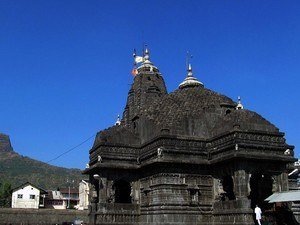

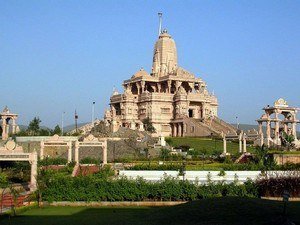

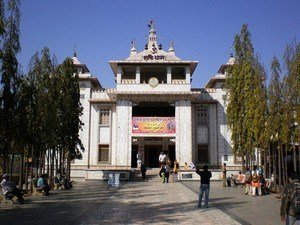
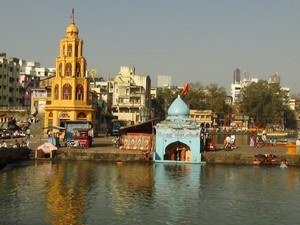


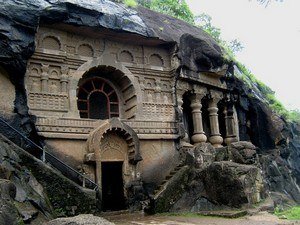
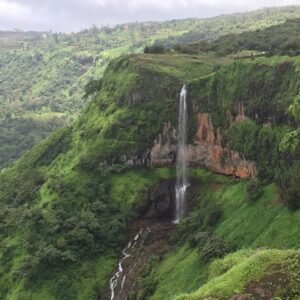
Reviews
There are no reviews yet.